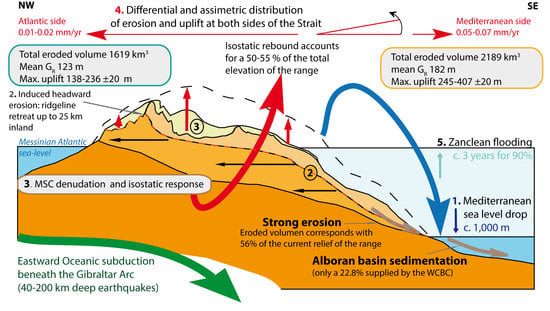

Remote Sensing, Vol. 12, Pages 3492: Quantification of Erosion and Uplift in a Rising Orogen—A Large-Scale Perspective (Late Tortonian to Present): The Case of the Gibraltar Arc, Betic Cordillera, Southern Spain
Remote Sensing doi: 10.3390/rs12213492
Authors:
Javier Elez
Pablo G. Silva
Antonio M. Martínez-Graña
The present study deals with the morphometric quantification of erosion and illustrates the uplift component triggered by denudation (isostasy) in the growth and evolution of a rising orogeny by the application of Airy isostasy concepts. The Gibraltar Arc, located in the Western–Central sector of the Betic Cordillera, developed an exceptional geological scenario during the Messinian Salinity Crisis since the thin emerged fringe of the uprising Cordillera disconnected the Atlantic and Mediterranean basins, generating a relevant misbalance and asymmetry in the fluvial erosion between the two slopes of the emergent orogeny. Our analysis was applied to 50 individual drainage basins (spatial isostatic units) in the Western–Central Betic Cordillera, allowing us to obtain individual and bulk estimates for these isostatic parameters. GIS-based numerical estimations were obtained using LiDAR Digital Elevation Models (DEMs) provided by the Spanish Geographical Institute and reconstructed pre-incision surface models obtained from proxy paleo-elevation data, estimated from stratigraphic and geomorphological littoral to shallow marine markers. The obtained values for geophysical relief, denudation plates, erosion/uplift rates and computed accumulated uplift (245 – 407 ±20 m) are higher for the ancient Mediterranean slope of the orogen. On the contrary, the Atlantic slope presents an accumulated uplift of only 138 -236 ±20 m, indicating the strong control of the ancient Messinian Atlantic–Mediterranean water divide. The temporal study of erosion indicates that most of the difference in uplift in the Mediterranean slope was achieved during or soon after the Messinian Salinity Crisis, resulting in mean uplift rates of 0.21 mm/y, but practically null (0.01 mm/y) for the Atlantic slope. The comparison of the geophysical relief models with proxy paleo-elevation data allowed us to assess the current state of the denudation process in the range. The results indicate that, towards the west of the range denudation compensated elevation, and is actively back-feeding isostatic rebound. Therefore, the contribution of external processes to mountain range elevation through isostasy is quantitatively estimated using elevation data. In this case, a relevant part of the surface uplift (50-55%) is undertaken by the orogen. Ultimately, the Messinian Salinity Crisis-related isostatic response to differential denudation may be behind the quaternary westward tilting of Iberia, causing more than 70% of the Peninsula to drain towards the Atlantic.
 This information was first published on https://www.mdpi.com/2072-4292/12/21/3492
This information was first published on https://www.mdpi.com/2072-4292/12/21/3492





More Stories
Facebook Fact-Checker CENSORS Heritage Video Quoting Biden’s Own Words on Gas Policy – March 19, 2022 at 06:49PM
General Mills (GIS) Gains But Lags Market: What You Should Know
CAD Designer